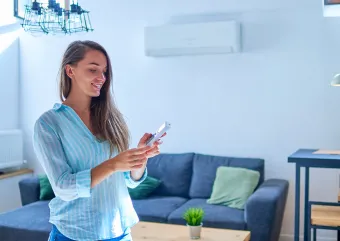For many homeowners, installing an air source heat pump zoning system improves comfort and reduces energy costs. This is true for both ducted and ductless systems.* Before investigating how zoning works with heat pumps, it’s important to understand the difference between ducted and ductless systems.
Ductless (mini splits)
Ductless heat pump units, or mini splits, don’t require ductwork. They consist of one or more outdoor and indoor units and are available in a variety of styles. Ductless systems are ideal for heating and cooling rooms without ductwork such as four-season porches, garages, and additions, or for supplemental heating in old homes with radiators during shoulder seasons. Cold climate models can deliver heat in temperatures well below 0°F. These units can be a practical solution for heating and cooling when ductwork isn’t possible or economical to add. Ductless systems can also be whole-home solutions, especially with open floorplans.
Ducted (central systems)
Ducted heat pump units, also known as central systems, are paired with a furnace and require ductwork to deliver heating and cooling throughout a home via forced air. Several manufacturers offer outdoor units that are compatible with any furnace, reducing the cost in some cases. Universal outdoor units are ideal for AC replacement and when the furnace doesn’t need to be replaced.
HVAC Zoning
Zoning allows homeowners to control heating and cooling settings in individual spaces, or rooms, rather than keeping the entire house the same temperature. Zoning controls can be installed with ducted and ductless heat pump systems. When set up properly, zoning controls can help homeowners save energy by only heating or cooling occupied rooms.
Tips for operating a zoned ductless system:
- Utilize motion sensors on ductless systems to detect when people are in the room. Many manufacturers offer this feature, which automatically turns the indoor unit on when motion is detected. If motion isn’t detected after a specified period, the unit shuts off. Operation of motion sensors with heat pumps is the same as motion detectors with lights.
- Shut units off when spaces are unoccupied using their remote control.
- Utilize built in timers if available. Timer controls may be included on the unit’s remote control.
Tips for setting up a zoned ducted system:
- Zoning a ducted system requires a thermostat with zoning capability. Each zone, or area of the home, needs to be programmed.
- Most major heat pump manufacturers offer thermostats with zoning, so be sure to discuss it with contractors when receiving quotes.
- If you have an existing ducted system and smart thermostat, you might already have zoning capabilities. Check the owner’s manual and thermostat settings or call the manufacturer to find out.
Author
Connect with a local contractor


